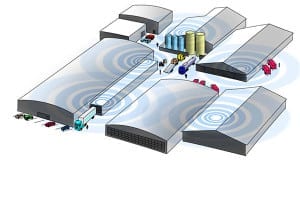Insight
Published and updated
13 Wireless Headset Must-Haves for Effective Team Communication
Edited: March 29, 2018.
Productivity, safety, and systems that help employees work smarter are your top priorities. You recognize that the effectiveness of your team communication with a wireless headset system has a major impact on project outcomes. Tasks will get done right the first time. Quality will be higher. Crews will finish jobs faster. Workers will be safer.
Now you just have to pick the right wireless headset brand and style for your application. Look for these 13 “must-haves” in your wireless headset solution.
13 Wireless Headset Must-Haves
- Get wireless without wires… A number of so-called “wireless” systems actually require a wire from the headset to a radio or belt pack. So much for freedom from dangling cords.
- What’s up, DECT? DECT offers many advantages over Bluetooth® technology, cell phones, and two-way radios for reliable team communication. DECT transmissions have multipath capability, meaning the signal will bounce up, over, and around objects in order to establish the best possible connection. For enhanced security, DECT signals are digitally encrypted to ensure privacy.
Comparison of DECT7 to other wireless technologies. 49 MHz 900 MHz 2.4 GHz 5.8 GHz DECT7 Range, feet 100 1500 300 150 1600 Security none Little to none Excellent Excellent Excellent Coexistence none none none none Yes - Full-duplex trumps half-duplex… Being able to talk, hear, and interrupt the way you can when you’re on a conference call is essential to clear communication and safety. This can only happen with full-duplex systems. ADDED BONUS: Look for a wireless headset system that lets you control which crew members can transmit over the radio if one is integrated with the system.
- Compatibility makes for a successful long-term relationship… Sometimes not all team members can be in the work zone. Make sure your system includes the capability to interface with remote users on any brand of mobile radio and/or Bluetooth® device.
- Prioritize comfort and usability… If wireless headsets are uncomfortable to wear or complicated to use, then your team won’t use them. They want solutions, not more problems. Wireless headsets should fit snugly but comfortably over the ears. They also need to fit comfortably with a hard hat. Controls have to be readily accessible to allow complete distraction-free communication with the team. Engaging the radio option needs to be as simple as a push-to-talk button or toggle-to-talk switch.

The right wireless headset needs to fit snugly in any configuration. - Prep for bigger jobs and larger teams… Your wireless headset system has to be able to expand with your business. Advanced systems can accommodate dozens of users.
- Don’t waste time on systems rated less than IP65… Unless every day is a spa day for your team, you need a rugged wireless headset that can perform consistently in your work environment. Reliability and longevity are hallmarks of high-quality, advanced wireless headsets. At IP65, your system will be completely impervious to dust and capable of withstanding a stream of water for three minutes without damage to the interior components.
- Keep hearing protection top of mind… Look for a noise reduction rating (NRR) of at least 24dB.
- Test the range… Every work zone is a little different. Elevation changes; equipment and buildings block lines of sight. Your wireless system should have a strong maximum range (1,500 feet minimum), and the technology to overcome the challenges of your jobsite to deliver clear communication where you need it.

Wireless headset systems need to work in varied environments, taking into account distance, structures, equipment, and elevation changes. - Know the operational temperature range… Extreme temperatures can affect battery life and wireless headset operation.
- What’s not included? The price you pay should deliver a complete system that is ready for operation, including accessories such as battery chargers and charging cables.
- Research the dealer and manufacturer… You want to get the most out of your investment. Make sure you know how your wireless headset works and where you can go for help. Your dealer is the critical link to expertise and the manufacturer.
- Review the warranty… A one-year limited warranty is common in the industry. Some vendors provide extended plans of up to five years.
More Wireless Headset Features
Other features to look for include listen-through technology, portability, length of use on a single charge, and more. Learn more about Sonetics solutions that include all of these must-haves and more.

